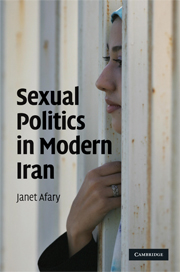Book contents
- Frontmatter
- Contents
- List of illustrations
- Acknowledgments
- Map of Iran
- Introduction
- Part 1 Premodern practices
- Part 2 Toward a Westernized modernity
- Part 3 Forging an Islamist modernity and beyond
- Conclusion: Toward a new Muslim-Iranian sexuality for the twenty-first century
- Glossary
- Bibliography
- Index
Conclusion: Toward a new Muslim-Iranian sexuality for the twenty-first century
Published online by Cambridge University Press: 05 June 2014
- Frontmatter
- Contents
- List of illustrations
- Acknowledgments
- Map of Iran
- Introduction
- Part 1 Premodern practices
- Part 2 Toward a Westernized modernity
- Part 3 Forging an Islamist modernity and beyond
- Conclusion: Toward a new Muslim-Iranian sexuality for the twenty-first century
- Glossary
- Bibliography
- Index
Summary
The lives of Iranian women changed substantially from the mid-nineteenth to the early twenty-first century. By 2007, the mean age at first marriage for women had gone up to 24 (from 19.7 in 1976), and more than 78 percent married after the age of 20. Literacy rates among girls and boys exceeded 95 percent, a majority of college students were women, the fertility rate had dropped to 2.0, and the infant mortality rate was 28 per 1,000 live births.
Although young men and women continued to consult and negotiate with parents about prospective partners, marriage increasingly became a prerogative of individual choice. Urban and rural youth formed friendships in public areas, universities, and workplaces despite Islamist prohibitions against the mingling of unrelated men and women. Cyberspace became a sphere where women dared speak about their intimate concerns, including sexual ones, often writing under pseudonyms. Among the more cosmopolitan middle classes, virginity was no longer crucial. Greater access to automobiles afforded more privacy, allowing more women to become sexually active before marriage. In some instances, young women negotiated to have premarital sex that maintained virginity or had access to safe but expensive hymenoplasty. Many parents in middle-class families accepted these facts, but more for sons than daughters.
No longer seen as mainly an institution for procreation, marriage now offered women possibilities for companionship, including emotional and sexual intimacy. Love was celebrated loudly and passionately.
- Type
- Chapter
- Information
- Sexual Politics in Modern Iran , pp. 360 - 373Publisher: Cambridge University PressPrint publication year: 2009



